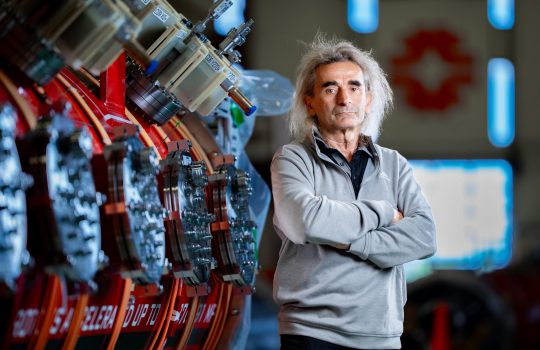
This architectural rendering shows the buildings that will house the new PIP-II accelerators. Architectural rendering: Gensler. Image: Diana Brandonisio
The following press release was issued today by the U.S. Department of Energy.
The U.S. Department of Energy invites citizens to review and comment on the possible environmental effects of building and operating the Proton Improvement Plan II (PIP-II) particle accelerator at DOE’s Fermi National Accelerator Laboratory. PIP-II is an upgrade to the existing proton accelerator complex at Fermilab. It will provide increased beam power to generate an unprecedented stream of neutrinos — subatomic particles that could unlock our understanding of the universe — and support a growing program of physics research for many years to come including the Deep Underground Neutrino Experiment.
The comment period is October 15 through November 15, 2018.
DOE’s draft environmental assessment analyzes impacts to human health and the environment from construction and operation of the proposed facility, including:
- Potential impacts on air, water and soil;
- Potential impacts to biological and cultural resources
- Potential impacts from construction accidents and transportation;
- Potential impacts to both workers and the public from potential exposure to radiation under both routine operations and credible accident scenarios; and
- Potential socioeconomic impacts.
DOE has posted the document online for public review and comment in accordance with its National Environmental Policy Act (NEPA) Implementing Procedures. It is available at pip2.fnal.gov/env-assessment.
The centerpiece of the PIP-II project is the construction of a new superconducting radio-frequency linear accelerator, which would fully modernize the frontend of the existing Fermilab accelerator chain and provide a platform for future enhancements. The plan is to install the new accelerator in a roughly 700-foot-long tunnel about 25 feet underground near Fermilab’s central laboratory building, Wilson Hall
The new accelerator will double the beam energy of its predecessor from 400 million to 800 million electronvolts. That boost will enable the Fermilab accelerator complex to achieve megawatt-scale beam power.
More information about the PIP-II project is available at pip2.fnal.gov.
There are two ways people can comment on the Draft Environmental Assessment:
- Mail: PIP-II Comments, U.S. Department of Energy, Fermi Site Office, P.O. Box 2000, Batavia, IL 60510; or
- Email: pip2.comments@science.doe.gov
All comments received during the official comment period will be given equal consideration.
Note that no public meeting is planned; however, those wishing to participate in a regularly scheduled tour of the Fermilab site should consult the following website: www.fnal.gov/tours/ for options. Depending on the tour, an overview of the project site from Wilson Hall would be possible.
For additional details about the project, visit the website linked to above or contact:
Mike Weis, Manager
U.S. Department of Energy
Fermi Site Office, MS 118
P.O. Box 2000
Batavia, Illinois 60510
630-840-2227
For general information concerning DOE’s NEPA process, contact:
Rick Hersemann, NEPA Compliance Officer
U.S. Department of Energy
Fermi Site Office, MS 118
P.O. Box 2000
Batavia, Illinois 60510
630-840-4122
rick.hersemann@science.doe.gov
DOE support of this project comes from its Office of Science’s Office of High Energy Physics.
DOE’s Office of Science is the single largest supporter of basic research in the physical sciences in the United States, and is working to address some of the most pressing challenges of our time. For more information, please visitscience.energy.gov.



